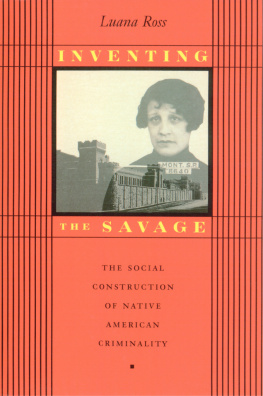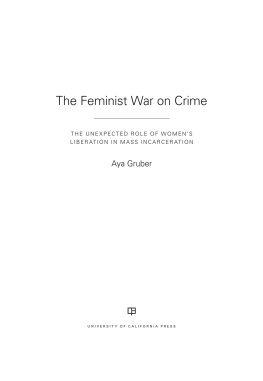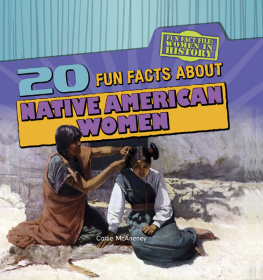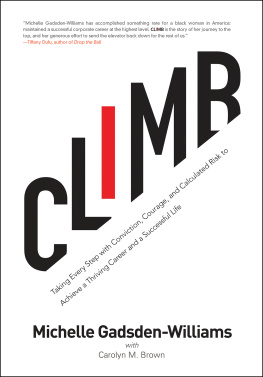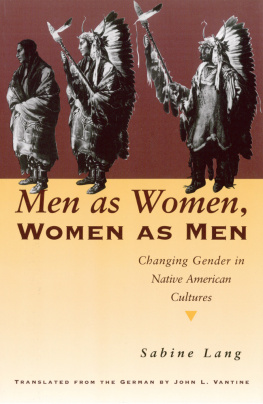Inventing the Savage
THE SOCIAL CONSTRUCTION OF NATIVE AMERICAN CRIMINALITY
by Luana Ross

UNIVERSITY OF TEXAS PRESS
AUSTIN
Permission granted by the Montana Historical Society Archives, Helena, to quote from RS 111: box 11, folders 2024, and MC 352: box 31, folder 3.
Excerpts from A Descriptive Case Study of the Impact of Social Learning Experiences on Adult Female Inmates (Ed.D. dissertation, Montana State University, 1995) reprinted by permission of Jerry D. McKinney.
Material previously published as Race, Gender, and Social Control: Voices of Imprisoned Native American and White Women, Wicazo Sa Review, 1994, reprinted by permission of the University of Minnesota Press.
Copyright 1998 by the University of Texas Press
All rights reserved
Printed in the United States of America
First edition, 1998
Requests for permission to reproduce material from this work should be sent to Permissions, University of Texas Press, Box 7819, Austin, TX 78713-7819.
Library of Congress Cataloging-in-Publication Data
Ross, Luana.
Inventing the savage : the social construction of Native American criminality / by Luana Ross. 1st ed.
p. cm.
Includes bibliographical references and index.
ISBN 0-292-77085-5 (cloth : alk. paper).
ISBN 0-292-77084-7 (pbk. : alk. paper)
1. Indian prisonersMontana. 2. Criminal justice, Administration ofMontana. 3. Women prisonersMontana. 4. Indian womenMontanaSocial conditions. 5. RacismMontana. I. Title.
E78.M9R67 1998
364.34970786dc21 97-21014
ISBN 978-0-292-75590-1 (library e-book)
ISBN 978-0-292-78768-1 (indiviual e-book)
This book is dedicated to all prisoners.
ACKNOWLEDGMENTS
I am truly blessed with wonderful relatives. Heartfelt gratitude is extended to my mother, Opal Cajune, for passing on to me her philosophical reasoning and sense of social justice. I offer thanks to my husband, Daniel Hart, and children, Shane Ross and Damon Hart, for their encouragement. I appreciate and honor my sisters, Julie Cajune, Kathy Ross, Ramona Cajune, Susie Ross, Duretta Billedeaux, and Ana Rowland. They continue to offer me support in a variety of ways. I also acknowledge my close cousins Rhonda Whiting, who is constantly encouraging, and Valerie McDonald, because of her extraordinary insight into the plight of imprisoned women.
Aside from family, colleagues played a crucial role in my work. I thank Jack Forbes, who read manuscript drafts, and Grieg Bustos, Susanne Bohmer, and Steve Talbot, with whom I spent many hours discussing Native American criminality. Longtime friends who were always encouraging and helpful and who are also valued colleagues include Sharon Elise, Wendy Ng, Annette Reed Crum, Irene Vernon, Gail Small, Franke Wilmer, and Cecilia Garland. Sincere appreciation is additionally extended to Larry Culp, the first professor to enlighten me on the role of extralegal factors in the invention of criminals.
As the project grew, it weathered the storm through several institutions. I thank Mary Romero and Linda Fuller from the University of Oregon for recognizing the topic as valuable and Rob Proudfoot for successfully decolonizing the defense of my dissertation. I acknowledge the support I received at Montana State University, particularly from Deborah Wetsit, the Womens Resource Center, and the Center for Native American Studies. At the University of California at Berkeley, the Ethnic Studies Department, especially Margarita Melville, deserves my thanks. I also extend my gratitude to the History of Consciousness Board at the University of California at Santa Cruz, especially to Angela Davis for allowing me the space and time in which to write. I am likewise thankful to all faculty and staff at the Native American Studies Department at the University of California at Davis for their support.
Gathering archival data was time-consuming and tedious. Bob Bigart from Salish Kootenai College, Elaine Way from the Powell County Prison Museum, and all staff at the Montana Historical Society were most helpful. I also acknowledge the Ford Foundation and the University of California for providing grants that afforded me the time in which to research and write.
Most important, I offer my appreciation to the prisoners and exprisoners who graciously and courageously shared their lives.
INVENTING THE SAVAGE
INTRODUCTION
And tears strong and deep will lift our voices in the public ear.
MONICA WALL [Salish] (1995)
I developed an interest in criminality, deviance, and imprisoned women because of my culture, race, gender, and experiences growing up on the Flathead Indian Reservation, home of the Sqlixw (Salish) and Aqlsmaknik (Kootenai). I was raised at the Old Agency across the street from the tribal jail. This jail was a tiny one-room structure that was seldom locked. Prisoners were seen walking and visiting around the Agency; no one was alarmed that they were not secured on a twenty-four-hour basis.
When I was young my godfather was training to be a Jesuit priest when, due to the illness of his father, he returned to our reservation. He was a wonderfully brilliant man who had been imprisoned four times. How could this possibly happen to a well-educated, spiritual person? My godfather was not my only relative who was imprisoned; other relatives preceded and followed. It is common for Native people either to have been incarcerated or to have relatives who have been imprisoned. Because we are a colonized people, the experiences of imprisonment are, unfortunately, exceedingly familiar. Native Americans disappear into Euro-American institutions of confinement at alarming rates. People from my reservation simply appeared to vanish and magically return. I did not realize what a real prison was and did not give it any thought. I imagined that all families had relatives who went away and then returned.
Academic issues, as well as personal, influence my interest in Native criminality/deviance. There is meager research on incarcerated Native Americans, although they are disproportionately imprisoned. Although insufficient attention is given to imprisoned women of color, the subject of imprisoned Native American women is virtually an unexplored area. Imprisoned Native women are invisible, and, as put forth by Patricia Hill Collins (1991), invisibility allows structural arrangements of inequality to exist.
I conducted the first study of imprisoned Native American women in 19901992. The purpose of the research was to give voice to these women by describing and defining their experiences as prisoners. I listened to the voices of the women, to their perceptions of their experiences as prisoners. While the state of Montana defines these women as criminal and dangerous, I find their lives complexbound up in race/ethnicity, gender, and class oppression. It is exhausting to recount the narratives of imprisoned womenthey were troublesome to hear. It is distressing to describe and name their pain. In the words of bell hooks (1992, 2), The more painful the issues we confront the greater our inarticulateness.
This is a book about the racialized and gendered experiences of incarceration, with a focus on Native American women and the loss of sovereignty as it is implicitly tied to Native criminality in complex, historical ways. This is also a book about the complexity of racism, as it evolved and took root in Montana, and the importance of race/ethnicity in Euro-American society.
Michael Omi and Howard Winant (1994) suggest that race is a socially constructed category that changes over time. The authors separate the shifting of race and racism into three chronological stages. In the first period, during the colonization of this country, race was discussed in biological terms complete with notions of the biological inferiority of people of color. In the second period, the early part of the twentieth century, ethnicity was substituted for race as differences between groups were defined and categorized. During this time, culture was added to the understanding of racial/ethnic relations and assimilationist paradigms were developed. The third period, emerging in a time of turmoilthe late 1960s and early 1970switnessed radical and nationalist movements, such as the Red Power and Black Power groups. The focus was on the differences between white Euro-America and people of color. The structure of society was used as a significant explanatory factor in the obvious inequality. Accordingly, race and racism were explained in terms of class- and nation-based theories. Ruth Frankenberg (1993), using the framework of Omi and Winant, asserts that all three movements and accompanying attitudes are found in contemporary Euro-America. Agreeing with Frankenberg, I term this
Next page
